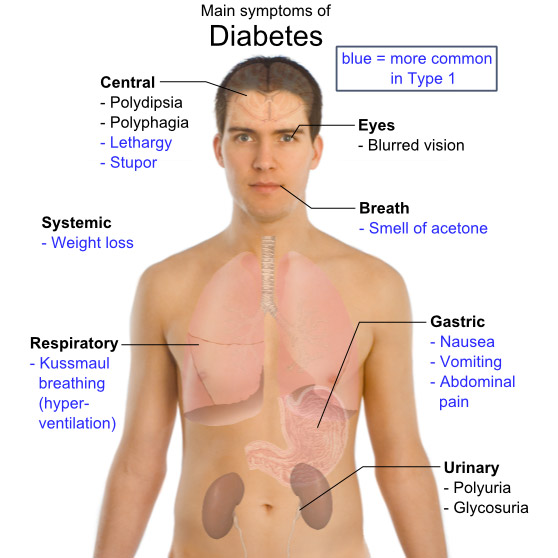Modest weight loss and regular exercise can prevent type 2 diabetes or play a role in controlling it. Adopting a healthy lifestyle, including making changes in diet and exercise, can make a big difference in your ability to manage this increasingly common disease. Read more about exercise and diabetes.
What is diabetes?
Diabetes is a condition in which the body does not produce or properly respond to insulin, a hormone secreted by the pancreas when glucose levels in the blood rise. Glucose is a sugar in carbohydrates, such as bread, pasta and rice.
Without insulin, glucose builds up in the blood and sticks to the vessel walls. This build-up will turn into plaque, causing atherosclerosis (hardening of the arteries), which in turn damages the blood vessel, increasing your risk of cardiovascular disease.
There are two main types of diabetes:
Type 1: When the body does not produce insulin. 10% of diabetes cases are type 1. Type 1 diabetes is not preventable and is not caused by lifestyle choices.
Type 2: When the body does not produce enough insulin or the body doesn’t use the insulin produced. 90% of diabetes cases are type 2. Type 2 diabetes is preventable and is caused by lifestyle choices.
Type 2 diabetes is often accompanied by cardiovascular risk factors and metabolic syndrome risk factors, such as dislipidemia, high blood pressure and obesity.
Managing diabetes:
 Losing just 15 pounds or less can make a big difference to your cholesterol and blood pressure. Exercising 30 minutes per day most days of the week has considerable health benefits and can be very helpful in managing blood sugar levels and promoting weight loss. Any type of exercise is good, including walking, swimming, dancing, yoga, cycling and aerobics.
Losing just 15 pounds or less can make a big difference to your cholesterol and blood pressure. Exercising 30 minutes per day most days of the week has considerable health benefits and can be very helpful in managing blood sugar levels and promoting weight loss. Any type of exercise is good, including walking, swimming, dancing, yoga, cycling and aerobics.
Exercise is also known to reduce the risk of coronary heart disease, cholesterol, body fat, triglyceride levels and blood pressure levels. Mild to moderate physical activity can also help lower blood sugar levels.
It is important to note that high-intensity exercise may actually elevate blood sugar levels during and immediately after exercise. You can prevent this if you do not exceed 85% of your maximum heart rate (220-age).
You should monitor your blood sugar levels around the time of exercise to identify patterns and develop strategies to optimally manage your levels.
Remember that lowering blood sugar levels through exercise depends on the intensity of exercise, medications being taken for diabetes, the amount of insulin in your body at the time of exercise, your level of insulin resistance, the time of day and any recent food intake.
Other things to keep in mind when managing diabetes:
- Avoid smoking
- Monitor your blood sugar levels
- Keep your cholesterol, triglycerides and blood pressure within your target range
- Take your medication as prescribed
- Manage your stress levels
- Follow a balanced meal plan
- Monitor the circulation in your extremities
- Visit your doctor, dentist and optometrist regularly
[/column]
How many of us have sat down in front of the TV, bag of snacks in hand, and before we realize it, finished the entire bag? Do you ever find yourself watching TV after dinner and eating still more food, even though the last thing you feel is hunger? Do you snack out of boredom or absent-mindedly stuff copious amounts of food in your mouth while out with friends? Here are a few tips to help you recognize mindless eating and kick the habit.
 1) Do not eat out of the bag, box or carton.
1) Do not eat out of the bag, box or carton.
Don’t take the whole bag of chips to the couch with you. Instead, place a handful into a small bowl. Then, close the bag and put it away. Walk away with your small bowl. If you return for seconds, it will at least be a partially conscious decision.
2) Do not eat in front of the TV.
When you eat while your attention is diverted (TV, computer, smart phone) you end up looking down and finding that the box of cookies you thought you just sat down with is completely empty! This can be referred to as the empty bag syndrome. You’ve consumed 1,000 calories of cookies without even noticing (or particularly enjoying them either).
3) Do not keep ‘weakness’ food around the house.
Avoid having a stash of weakness foods lying in your pantry, quietly awaiting your next mindless snack attack. If it happens that you do slip into mindless mode—we all do on occasion—you can reach for things like low-fat popcorn, vegetables, fruit or something else on the healthy side. Think about the foods you are going to keep in the house before hand. If are about to eat something mindlessly, by definition, you are not going to be paying much attention to what it is. Why not have it be stuff that will not make you regretful?
Flying south this winter? According to Statistics Canada, Canadians made 18,915,000 trips to the USA and 1,125, 000 trips to Mexico in 2008.
The states most visited in the USA included Florida and California. Clearly many of us take a break from the harsh Canadian winter! If you’re a snowbird, there are certain illnesses that may present in your destination, some of which are vaccine preventable.
California: Whooping Cough (Pertussis)
2010 saw the highest number of reported cases of pertussis in California in 60 years. Fortunately, pertussis is vaccine-preventable. Children are routinely vaccinated for pertussis in Alberta. However, every adult should receive at least one pertussis vaccination.
Florida: Dengue Fever
Dengue is a viral disease carried by mosquitoes. It is very common around the world and leads to about 25,000 deaths each year. Since 1980, there have been cases of dengue along the border between Texas and Mexico and, in 2009, 25 cases were identified in Florida.
You cannot be vaccinated against dengue fever, nor is there medication you can take to prevent or treat the illness. Personal protective measures (PPM) should be used to prevent mosquito bites. Some examples of PPM that we recommend include using:
- Lightweight, light-coloured, loose-fitting clothing
- Air-conditioning and screened windows
- Mosquito repellents containing DEET
Mexico: Hepatitis A
Hepatitis A is a liver disease that spreads through contact with infected people or through food and water. The Public Health Agency of Canada identifies Mexico as a high-risk destination for hepatitis A.
Hepatitis A is vaccine-preventable. You will need two doses: one at day zero and a second booster shot six to 12 months later. With little exception, anyone over the age of one year can be vaccinated against hepatitis A.
These are just a few of the illnesses you risk when travelling south for the winter. Speak with your physician or travel medicine specialist for more details on how to enjoy a safe and healthy trip.
The snow is falling and the mountains are calling your name. Winter in Calgary is perfect for all sorts of outdoor activities: downhill skiing, snowboarding, cross-country skiing and snowshoeing! Weekend after weekend you put yourself through a great physical challenge. Prepare your body for these activities through strength training will help you have more fun, without pain or injury.
 Many winter activities use the strength and power of the lower body. The lower body holds the largest and strongest muscles, which many of us neglect all summer. Come first snowfall, we are out there on the mountain unable to participate to our full capacity because our legs are tired after two runs. And man are we sore the next day!
Many winter activities use the strength and power of the lower body. The lower body holds the largest and strongest muscles, which many of us neglect all summer. Come first snowfall, we are out there on the mountain unable to participate to our full capacity because our legs are tired after two runs. And man are we sore the next day!
Strengthening your muscles before the season starts will also help prevent injury. Our joints endure a tremendous amount of pressure and instability in many winter activities. If we have strong muscles, ligaments and tendons surrounding the joints, there is less of a risk of injuring the joint. For example, many of us know of someone who has torn the ACL or meniscus in the knee while downhill skiing. This injury can be prevented if you have a strong quadricep and hamstring muscle surrounding the knee joint because these muscles do not allow the knee to torque in a way that will tear those ligaments.
Being strong going into your winter season of fun will also help with your recovery process. Many of us have woken up after a day of fun unable to hop out of bed. Muscles have memory and must practice to remember. They get used to the movement and the way they are required to fire to move properly. The more you do it, the easier it is and the less sore you are!
So as the winter approaches and you get your equipment ready by waxing, sharpening and tightening, think about preparing your body. It is the most important piece of equipment you have.
On Your Own
Focus on strengthening the quadriceps, hamstrings and gluteal muscles. Some exercises that you can do on your own to prepare your muscles are squats, lunges and balancing exercises. These can be done with no weight as they are only for range of motion purposes.
With Your Trainer
To start developing strength and power so you can last longer, you should consult a personal trainer. This ensures you are progressing with weights properly and executing the exercises correctly.
A good night’s sleep is a critical part of a healthy lifestyle, for you and your children. Here are our top tips for sleep-deprived parents and kids.
Know How Much Sleep is Necessary
Everybody’s different, but in general, newborns need about 16 hours each 24-hour period while babies over six months need about 14 hours. Toddlers should get between 10 and 13 hours and preschoolers between 10 and 12 hours.
Give Cues
Newborn babies need to know what you want them to do in order to develop routines. If it’s time to sleep, let baby know by, for example, singing him a song and laying him gently in his crib.
Give Comfort
It’s tempting to pick up your crying seven-month-old when she wakes at night. But giving a comforting pat and some gentle reassurance will help her settle faster than if you take her out of the crib.
Transition Gently
Toddlers and older children need time to move from their activity-filled lives to bedtime. Plan quiet time for the last half hour before tucking them in.
Unplug Early
Television, computers and other electronics can interfere with a good night’s sleep. Preschoolers need time without these things for a half hour or so before bedtime.
Talk About Nightmares
Bad dreams are part of life and really can be scary for children. Take time to reassure your child that dreams are not real and that she is safe.
See the Doctor When Necessary
If an issue like consistent loud snoring or night terrors is worrying you, discuss it with your doctor. He or she is there to help make sure you and your child are getting the sleep you need to reach peak health and live the life you desire.

